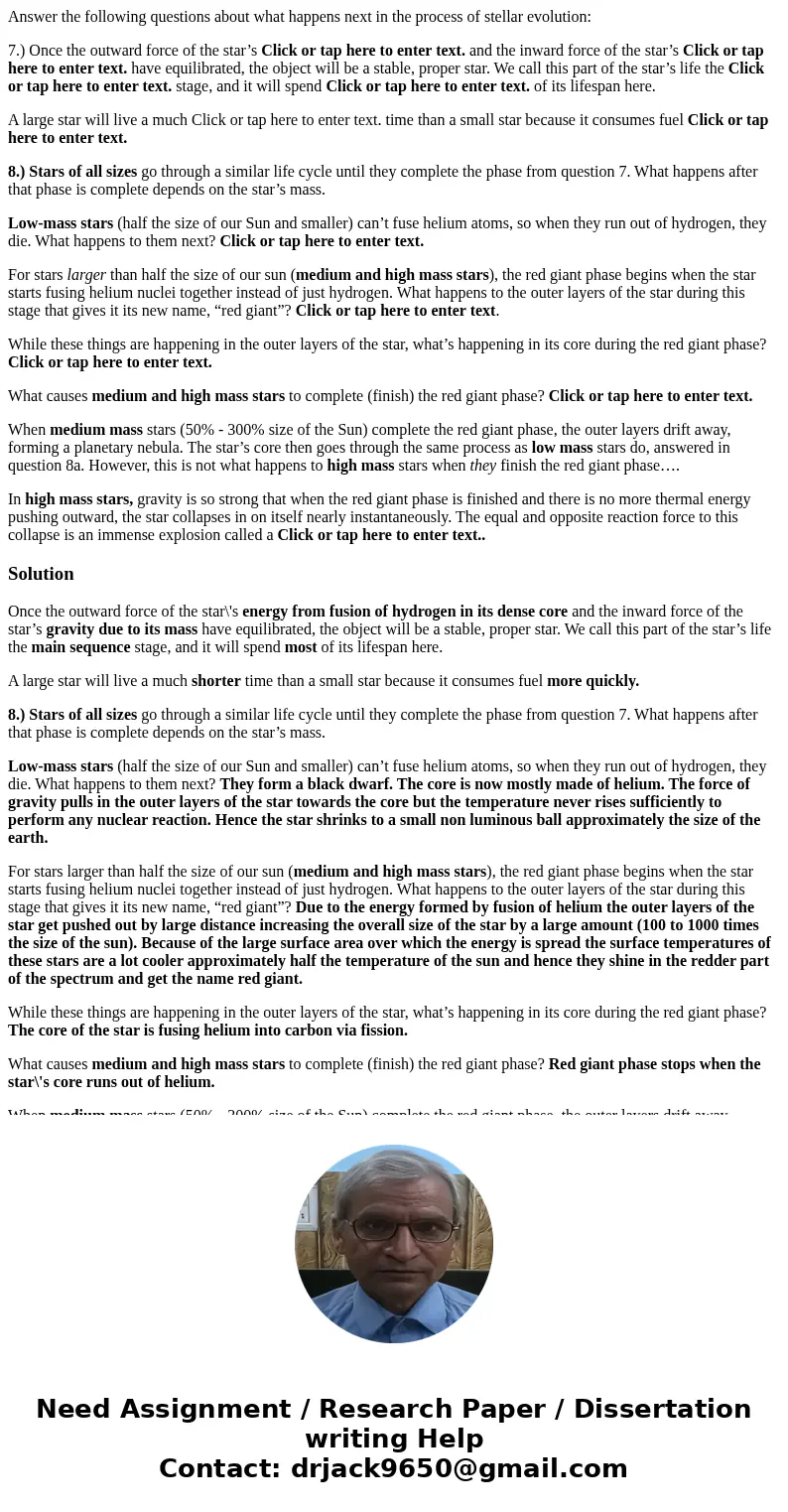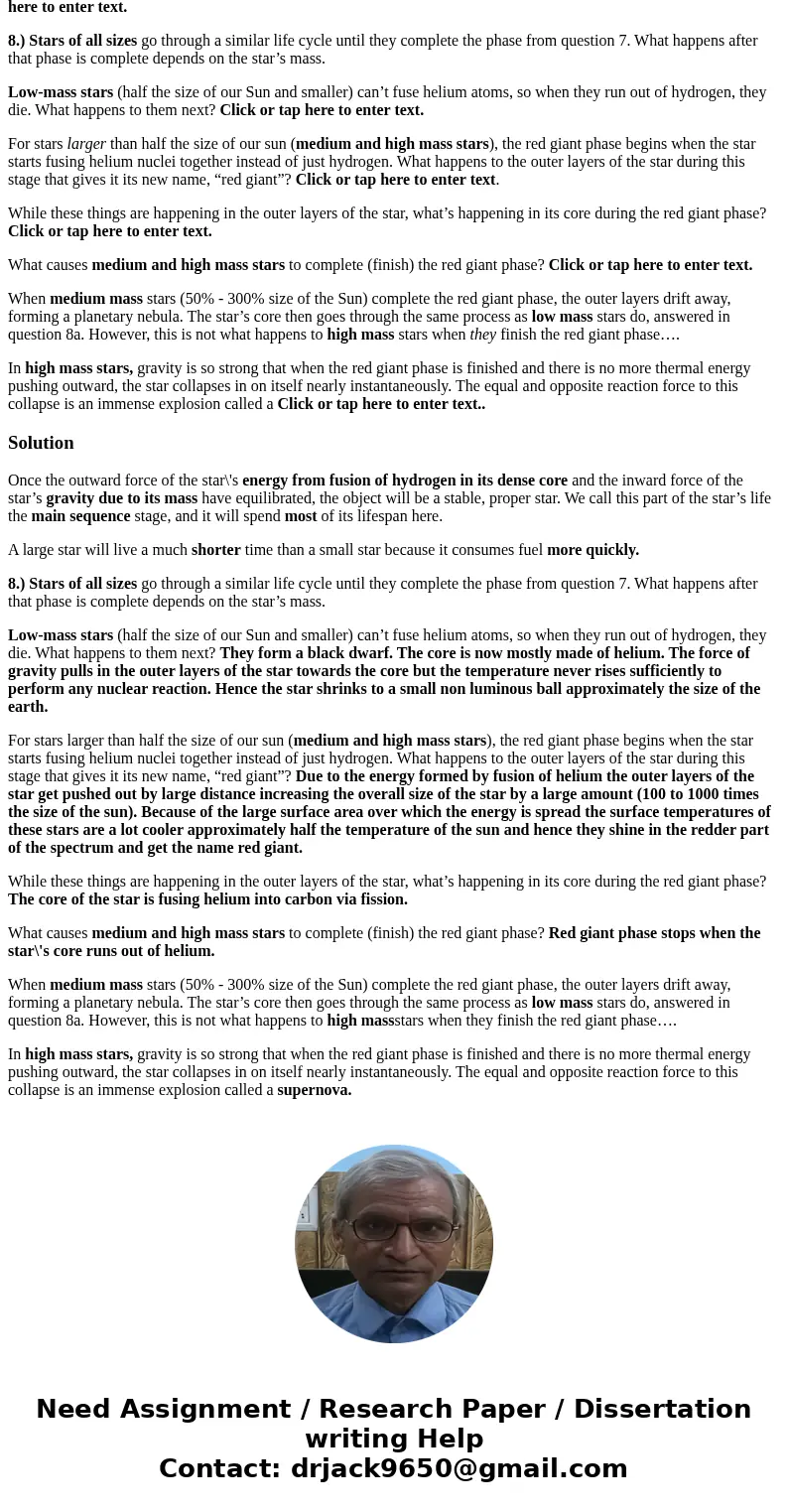Answer the following questions about what happens next in th
Answer the following questions about what happens next in the process of stellar evolution:
7.) Once the outward force of the star’s Click or tap here to enter text. and the inward force of the star’s Click or tap here to enter text. have equilibrated, the object will be a stable, proper star. We call this part of the star’s life the Click or tap here to enter text. stage, and it will spend Click or tap here to enter text. of its lifespan here.
A large star will live a much Click or tap here to enter text. time than a small star because it consumes fuel Click or tap here to enter text.
8.) Stars of all sizes go through a similar life cycle until they complete the phase from question 7. What happens after that phase is complete depends on the star’s mass.
Low-mass stars (half the size of our Sun and smaller) can’t fuse helium atoms, so when they run out of hydrogen, they die. What happens to them next? Click or tap here to enter text.
For stars larger than half the size of our sun (medium and high mass stars), the red giant phase begins when the star starts fusing helium nuclei together instead of just hydrogen. What happens to the outer layers of the star during this stage that gives it its new name, “red giant”? Click or tap here to enter text.
While these things are happening in the outer layers of the star, what’s happening in its core during the red giant phase? Click or tap here to enter text.
What causes medium and high mass stars to complete (finish) the red giant phase? Click or tap here to enter text.
When medium mass stars (50% - 300% size of the Sun) complete the red giant phase, the outer layers drift away, forming a planetary nebula. The star’s core then goes through the same process as low mass stars do, answered in question 8a. However, this is not what happens to high mass stars when they finish the red giant phase….
In high mass stars, gravity is so strong that when the red giant phase is finished and there is no more thermal energy pushing outward, the star collapses in on itself nearly instantaneously. The equal and opposite reaction force to this collapse is an immense explosion called a Click or tap here to enter text..
Solution
Once the outward force of the star\'s energy from fusion of hydrogen in its dense core and the inward force of the star’s gravity due to its mass have equilibrated, the object will be a stable, proper star. We call this part of the star’s life the main sequence stage, and it will spend most of its lifespan here.
A large star will live a much shorter time than a small star because it consumes fuel more quickly.
8.) Stars of all sizes go through a similar life cycle until they complete the phase from question 7. What happens after that phase is complete depends on the star’s mass.
Low-mass stars (half the size of our Sun and smaller) can’t fuse helium atoms, so when they run out of hydrogen, they die. What happens to them next? They form a black dwarf. The core is now mostly made of helium. The force of gravity pulls in the outer layers of the star towards the core but the temperature never rises sufficiently to perform any nuclear reaction. Hence the star shrinks to a small non luminous ball approximately the size of the earth.
For stars larger than half the size of our sun (medium and high mass stars), the red giant phase begins when the star starts fusing helium nuclei together instead of just hydrogen. What happens to the outer layers of the star during this stage that gives it its new name, “red giant”? Due to the energy formed by fusion of helium the outer layers of the star get pushed out by large distance increasing the overall size of the star by a large amount (100 to 1000 times the size of the sun). Because of the large surface area over which the energy is spread the surface temperatures of these stars are a lot cooler approximately half the temperature of the sun and hence they shine in the redder part of the spectrum and get the name red giant.
While these things are happening in the outer layers of the star, what’s happening in its core during the red giant phase? The core of the star is fusing helium into carbon via fission.
What causes medium and high mass stars to complete (finish) the red giant phase? Red giant phase stops when the star\'s core runs out of helium.
When medium mass stars (50% - 300% size of the Sun) complete the red giant phase, the outer layers drift away, forming a planetary nebula. The star’s core then goes through the same process as low mass stars do, answered in question 8a. However, this is not what happens to high massstars when they finish the red giant phase….
In high mass stars, gravity is so strong that when the red giant phase is finished and there is no more thermal energy pushing outward, the star collapses in on itself nearly instantaneously. The equal and opposite reaction force to this collapse is an immense explosion called a supernova.


 Homework Sourse
Homework Sourse